Here’s your personal copy of the new issue of The Ryder
Unlike other publications that feature year-end reviews before January 1st, at The Ryder it’s a tradition not to start production on our annual retrospective until after the dawning of the New Year. We do this in part so some on our masthead can enjoy the holidays, but also so we can shoehorn in considerations of late-breaking events that happen right up to the moment the departing year gives up the ghost.
Late-breaking events in 2020 once again validated our quirk – we’d have been heartbroken if we couldn’t have had John Bob Slone weigh in on the December 30th passing of Gilligan’s Island icon Dawn Wells as he does on page 56 of this issue. Then, just as our production cycle was closing, January 6th happened.
Like many the world over, the extended Ryder family struggled to process what it saw. As we prepare to publish, we have no idea what’s going to unfold in Washington, DC, between now and the Joe Biden inauguration on January 20th. And, in this, we know we’re not alone, either. But that’s kind the de facto theme of this issue: interconnectedness.
Bloomington isn’t Brigadoon. Geographically, psychologically, financially, artistically, politically, despite our “blue island” status, we are part of larger wholes: the region, the state, the nation, the world, the environment; formal and informal professional and social networks. So we asked not just some of our usual Bloomington contributors to weigh in with considerations, but folks from outside Bloomington as well. The New York Times’ John Schwartz, playwright Richard Byrne, jack-of-all-tradesman Kent Jenkins Jr, Aussie reporter Ross Coulthart, editor Jeff Sartain and, via Jason Vest, honorary Bloomingtonian James McMurtry all answered the call. And, in considering both immediate past and immediate future of living in a one-party state, ace Indiana political reporter Brian Howey reminds that possibly the only thing more divisive than a literal wall is a shrewdly-drawn electoral district line.
These days of course, you don’t have to live a world away to feel like you’ve living in an unfamiliar land. And if you should go somewhere foreign, you might find that in some respects it’s not that different from home, as perpetual wanderlusters Mason Cassady and John Linnemeier share in this issue through two very different experiences: In Mason’s case, braving the threat of guns and dogs while roaming through the backroads of southern Indiana, armed with nothing but a US Census Bureau clipboard; and in John’s case, discovering a better angel of human nature alive in spirit on a remote Atlantic island.
From her perch in Madison, Indiana, author, Hanover College professor and former Bloomingtonian Robyn Ryle considers best reads of 2020 through an engagingly idiosyncratic lens, while closer to home our own Joan Hawkins locates her Best in Film 2020 list in the midst of quiet revolution of pandemic-bound US audiences against the provincialism not of Americans, but of American film distributors. Our own Brian Stout kicks off a diverse set of 2020’s musical standouts, with help from some of the best on-air personalities of WFHB. And in additional to asking local sci-fi/fantasy sage Dan Melnick to share his 2020 TV favorites, we also opened up considerations of memorable TV moments to the growing Ryder family.
Someone once said, “Don’t look back.” Bob Dylan? Satchel Paige? Maybe both of them. This isn’t the first time we’ve ignored sound advice from our elders. Actually, that’s our job. We hope you have as much fun reading this issue as we did putting it together.
The Ryder is distributed free and costs are normally covered by advertising, but not during the pandemic. This issue of The Ryder is funded in part by a Recover Forward grant from the Bloomington Urban Enterprise Association, The grant covers some of our expenses, but not all.
As you flip through this issue of the magazine (118 pages this month!) if you should see a story that you like, or if you would just want to support local, independent journalism, please consider making a donation.
Category: Features
-
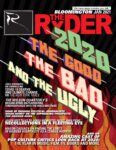
New issue of The Ryder
-

tHIS wEEK’S rYDER fILMS
Here’s what’s showing this week in our virtual theater. And if you have not seen the new issue of The Ryder magazine, here it is
from Argentina: The Weasel’s Tale

Schemers meet their match in The Weasel’s Tale, a comedic thriller by Academy Award-winning filmmaker Juan José Campanella (The Secret in Their Eyes). Four long-time, showbiz friends share a decaying mansion in the countryside outside of Buenos Aires. Their peaceful coexistence is menaced by a young couple who, feigning to be lost, slowly insinuate themselves into their lives. It’s Sunset Boulevard meets The Best Exotic Marigold Hotel, with a Latin twist. Financial gain, seduction, betrayal, and memories run amok are the elements that create the recipe for this delightful game of cat…and weasel. Find out more »
from Romania: COLLECTIVE

ONE OF THE GREATEST MOVIES ABOUT JOURNALISM and the Dark Forces it Confronts…Alexander Nanau’s bracing, relentless documentary plays like a gripping real-time thriller, merging the reportorial intensity of Spotlight with the paranoid uncertainty of The Manchurian Candidate. When Nanau screened Collective to rave reviews at the Venice, Toronto and Sundance festivals, he had no idea that his exposé would prove to be all-too predictive of a world not prepared to cope with a rampaging virus pandemic. – Indiewire …Find out more »
DAMNATION
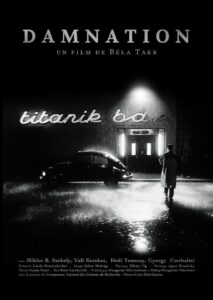
A loner tries to win back his estranged lover, a lounge singer in a bar named Titanik, in Hungarian filmmaker Bela Tarr’s otherworldly film noir. Some of you may have seen Tarr’s classic, 7-hour film Satantango when it was screened at the IU Cinema in 2019. Relax, Damnation is a mere 1 hour, 56 minutes. Find out more »
MAYOR
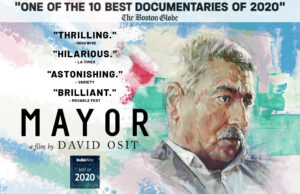
Filmmaker David Osit subtly – and with a keen eye for black humor – explores the absurdities of a worldly politician trying to turn his city into a Middle Eastern Amsterdam while in the midst of a geopolitical storm. His ultimate mission: to end the occupation of Palestine. Rich with detailed observation and a surprising amount of humor, Mayor offers a portrait of dignity amidst the madness and absurdity of endless occupation while posing a question: how do you run a city when you don’t have a country? Find out more »
FREE TIME
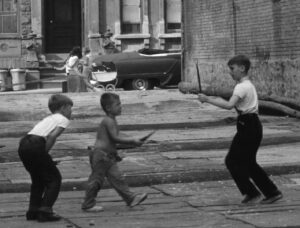
Free Time, is the latest film by one of our greatest documentarians, Manny Kirchheimer. A New York Film Festival selection, Free Time presents meticulously restored and poetically assembled 16mm black-and-white footage shot in New York between 1958 and 1960, set to the stirring music of Ravel, Bach, Eisler, and Count Basie. Manny Kirchheimer is one of the great masters of the American city symphony, as is clear from films like Stations…Find out more »
opens Jan 22: FILM ABOUT A FATHER WHO

Over a period of 35 years between 1984 and 2019, filmmaker Lynne Sachs shot 8 and 16mm film, videotape and digital images of her father, Ira Sachs Sr., a bon vivant and pioneering businessman from Park City, Utah, the Utah skiing enclave where the Sundance Film Festival is held. Film About a Father Who is her attempt to understand the web that connects a child to her parent and a sister to her siblings. Critics’ Pick! This brisk, prismatic and richly psychodramatic family portrait finds Sachs assessing her relationship with her father, Ira Sachs Sr., described at one point as the “Hugh Hefner of Park City.” ” –The New York Times
opens Jan 27, from France: The Salt of Tears

Veteran filmmaker Philippe Garrel once again fashions a pinpoint-precise and economical study of young love and its prevarications, which ever so gradually blossoms into an emotionally resonant moral tale. Photographed in black-and-white, The Salt of Tears shares much of the sensibility of François Truffaut’s early romantic adventures starring the insufferable (and insufferably adorable) Antoine Doinel.…Find out more »
opens Jan 29: ATLANTIS
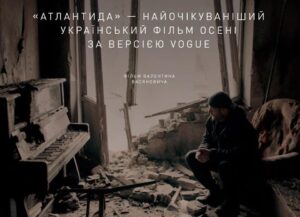
A prize-winner at the Venice Film Festival and Ukraine’s official selection for the 2021 Academy Awards, Atlantis is a gorgeous and visionary sci-fi drama….Eastern Ukraine, 2025. A desert unsuitable for human habitation. Water is a dear commodity brought by trucks. A Wall is being build-up on the border. Sergiy, a former soldier, is having trouble adapting to his new reality. He meets Katya while on the Black Tulip mission dedicated to exhuming the past. Together, they try to return…Find out more »
opens Feb 5 M.C. Escher: Journey To Infinity

A staircase that leads back to itself; waterworks that move towards and away from the viewer at the same time; an impossible box: M.C. Escher’s artworks feature perspective impossibilities that are world famous. To the eyes, Escher is simply a genius artist. But for art theorists, Escher was never easy to classify. M.C. Escher: Journey To Infinity is the story of world famous Dutch graphic artist M.C Escher (1898-1972). Equal parts history, psychology, and psychedelia, Robin Lutz’s entertaining, eye-opening portrait…Find out more »
-

Passages
Craig Brenner’s seventh album reflects a difficult time in his life
By Mike Leonard
It’s been said that artists sometimes create their best work when their stress and anxiety metrics are high, and the observation could easily apply to Craig Brenner’s seventh album, Passages.
Shortly after receiving a grant from the Indiana Arts Commission to record the album, the longtime Bloomington resident learned that his younger brother, Dan, his “oldest and dearest friend from the time we were little boys,” was diagnosed with terminal cancer.
After that, his mother, now 96, took the latest of several age-related falls, fractured her femur, and was confined to a long-term healthcare facility near her home in Florida. While she never contracted Covid-19, the health precautions caused by the pandemic made access to seeing her difficult at times and impossible at others.
The pandemic also put the brakes on live performances — a dispiriting and financially impactful development for virtually all working musicians. The spread of Covid-19 also pushed back the recording schedule for Passages and required a rethinking of an important component of the arts commission grant, teaching and performing the music with students.
The perennially good-natured pianist and composer takes a “and can you believe it” tone when he adds that his beloved black cat, Tut, died in the middle of all of this. Tut, the lovable jazz cat that hopped up on the piano whenever Brenner played at home and occasionally pranced across the piano keys — mostly to Brenner’s amusement, but not always.
The trips to Florida to settle his brother’s estate and grieve, visit his mother and grieve, and deal with the chaos and uncertainty took a toll. “The last year-and-a-half has been horrible for me,” Brenner acknowledges.
It all figured in to Brenner’s state of mind in making “Passages.” How could it not?
“I feel that there’s somewhat of a dichotomy in the album in things that are poignant and sad and things that are more upbeat,” he mused.
Poignancy might be the better descriptor, despite the sadness the composer felt. The opening track, “Life is Precious” is something of an opening and closing statement. It was originally titled “You Won’t Hear It Again” but it’s far from gloomy. More like a celebration of the beauty and elegance of jazz piano, with Dan Hostetler on drums and Ron Kadish on double-bass.
“There’s a dichotomy in the album,” Brenner muses. There are “things that are poignant and sad and things that are more upbeat.”
“Tut’s Boogie Woogie” pays homage of Brenner’s feline buddy and shows off the rollicking boogie woogie piano chops for which Brenner is well-known. For the uninitiated, Brenner launched the Bloomington Blues & Boogie Woogie Piano Festival in 2015 and has brought to Bloomington artists including Bob Seeley, Henry Butler, Marcia Ball and C.J. Chenier. His peers.
Brenner also demonstrated rock, blues and rhythm-and-blues proficiency during years of playing with Bloomington’s best bar band, The Ragin’ Texans. His tastes, and skills, are broad.
“Some Sexy Blues For Ya Right Here, Y’All” got its name from Brenner’s wife and vocalist Lori Brenner, who heard the song fleshed out and made the memorable observation. She nailed it, as did the supporting cast of Hostetler, Kadish, cool blues guitarist Gordon Bonham and hot saxophone player, Joe Donnelly.
And in the ‘it’s harder to do than it sounds’ category, “Paradiddle Boogie Woogie” romps to an unusual twist with Brenner alternating hands on the piano to carry the role drumsticks normally pound out.
Are there sad songs on “Passages?” Again, poignant seems to be better word. “No One Should Die Alone” feels like a tribute to the beauty of the human spirit and the fragility of the mortal coil, inspired by the isolation of his mother at her health care facility and the fate of many COVID-19 patients unable to receive visits from their families.
“For My Brother” is elegiac and majestic, with violinist and viola player Dana El Saffer elevating the piano-based tune into the realm of regal. “I wrote lyrics to it but I couldn’t bring myself to sing it,” Brenner said. “Maybe some day.”
Sonically, “Passages” sparkles with the all-star cast of mostly Bloomington-based musicians finding ways to ply inventive solos and fills within the framework tone of the songs. Recorded primarily at Airtime Studios, it also benefits from the recording, mixing and mastering of Airtime owner Dave Weber and his much-admired Yamaha concert grand piano. “The sound of that piano is incredible,” Brenner said. “It’s definitely one of the best pianos around.”
Brenner notes that his “favorite singer,” his wife Lori, not only contributes vocals to the album but also the handsome album art. The family contributions also include electric bass from his son, Nate, and vocals from Nate’s wife, Merrill Garbus, the nucleus of the eclectic Oakland, California-based group Tune-Yards (whose 2011 album, Whokill was named album of the year in The Village Voice’s annual Pazz and Jop critics poll).
Nate and most of the album’s musicians dive into a musical pile of funhouse balls in the album’s final cut. “I originally wrote and performed ‘Looking For A Job’ back in the 1980s with both Kruise Kontrol and Sajonner, a trio with Saaku Saar and T.J. Jones,” Brenner said. The reggae-influenced song was inspired by the unemployment and economic sputtering and shifting under the Reagan administration and includes honks and squeals and synthesizer sound effects to capture the unpredictable mood.
It’s the most incongruent track on “Passages” and clearly the most fun. Perhaps it’s Brenner’s way of bookending the album. Life IS precious. And music feeds the soul.
Passages is available on CD (discounted at Landlocked Music) and downloads at www.craigbrenner.com. Videos of several students performing pieces from the album are also posted on the website.
CONTACT: Craig Brenner, 812-929-1784, craigbrennerboogies@gmail.com
Mike Leonard retired from The Herald-Times after nearly 35 years as a columnist and reporter. He is currently a freelance writer and adjunct lecturer in The Media School at Indiana University. Mike Leonard, 812 369-1532, leonardbtown@gmail.com
-

The Forgotten Folk: B-Sides from The Harry Smith Folk Anthology
The Carter Family (left to right) Maybelle, Sara, and A.P.
By Tom Roznowski
For masterpieces are not single and solitary births; they are the outcome of many years of thinking in common, of thinking by the body of the people, so that the experience of the mass is behind the single voice.
– Virginia Woolf, A Room of One’s OwnDown by a western water tank
One cold December day
– Dick Justice, The Harry Smith B-Sides (Track 1, Disc 1)And now it lies broken. Probably for the length of our lifetimes. The deep divisions in America around race and class, which were always rooted in wealth, have stunned us all into collective dysfunction. The depth of our divisions were clearly exposed in a yea or nay national referendum. The result of that democratic exercise illuminated this estrangement for all to see. As for the business of resolving policy issues or choosing a future direction, the outcome of this once-in-a-generation election decided nothing.
Backward glances are not natural to Americans. If we have never quite measured up as a forward-thinking people, we can at least be considered a forward-looking people. Each of the major migrations in our nation-building: across the Atlantic to North America, westward into the frontier, or more recently from farm to city, required a personal resolve to never glance back at the consequences of your actions, or stop and consider how they might be slowly gaining on you.
One manifestation of this resolve has been the exploitation and subsequent abandonment of large portions of lands and people, stretching from sea to shining sea. You don’t have to look far for evidence of the damage done anywhere east of the Mississippi: the vacant small towns, the impoverished mountain communities, the tired aging cities. No question that daily life was hard for many even when these areas were thriving. In fact, as we can see now, that’s exactly what allowed them to thrive in the first place.
The Harry Smith B-Sides, recently released as a handsome boxed set by Disc-To-Digital, provides listeners a director’s cut of an already legendary work. These are the companion tunes for the A sides from original 78 r.p.m. releases that appeared on The Anthology of American Folk Music curated by Harry Smith. That initial collection, released by Folkways Records in 1952, featured 84 performances of American roots music, the majority recorded in just three years, from 1927 through 1929. The selections are divided into three categories: Ballads (the English folk tradition of storytelling through song), Social Music (played and sung where people gathered: primarily church and dances) and finally, Songs (covering the waterfront with meditations on birds, prison time, rough neighborhoods, and fishing).
As distinctive as the sources and subjects of these performances are, there is a cohesion that binds each of these collections together as a concept. This is astounding, especially given the social, racial, and class divisions that coursed through America at the time. A period photograph of African-American and Cherokee musicians Andrew and Jim Baxter (Georgia Stomp b/w 40 Drops) reveals perhaps more than was intended. The two men are seated outdo15ors posing with their instruments. They are apparently the invited entertainment for the day. Behind them, at a remove of perhaps 10 yards, a group of fashionably dressed white women stand behind a long table. Welcome to Gordon County, Georgia in the 1920s.
Of course, being uniquely American, the original Anthology American of Folk Music was a serendipitous combination of creativity, evolving technology, and market forces. In the mid to late 1920s, the process used to capture live music took a huge leap with the introduction of electronic recording, vastly improving the fidelity of performances. Voices and instruments no longer had to shout to be heard. Almost overnight, Enrico Caruso became Bing Crosby.
These advances moved in lockstep with a growing consumer market eager for portable, re-playable versions of folk songs by rural artists; performances that a couple decades earlier could have been absorbed only in the moment. What Gutenberg’s press did for story, the 78 rpm record did for roots music. Yet another step away from the imme15diate and the individual, anticipating that a broad acceptance would surely follow.
Harry Smith was not a musician, but he listened like one. He was a genuine eccentric born of eccentrics. His mother claimed to be the vanished daughter of Czar Nicholas, Anastasia. His father had once been a cowboy. Every bit as essential as his fascination with American folk music was young Harry’s penchant for collecting. Whatever he earned at various odd jobs was largely spent acquiring ephemera: catalogues, paper airplanes, painted Easter eggs. Around 1940, Harry Smith began to accumulate commercially released folk recordings created during this rich three-year period of the late 1920s. Conveniently, Harry’s curiosity and energy coincided with yet another enormous shift in recording technology that had occurred during the late 1940s: the emergence of LPs (Long Players) spinning at 33 1/3 rpm and the conversion of two song, A and B side releases from 78 to 45 rpm., which facilitated the growing popularity of jukeboxes.
In the 1920s, the B-sides were often where the racy, and racist, songs were consigned.
In response to this market shift and eager to create warehouse space for new releases, major record labels began off-loading their remaining stock of 78s to local retailers for pennies on the dollar. Much of that stock had been sitting undisturbed during the Depression and World War II. With few notable exceptions, the musicians who had performed on these recordings had either moved on with their lives or simply died.
The initiative to release The Anthology of American Folk Music in 1952 was guided by Moe Asch of Folkways Records. The new LP format had made it marketable. Harry Smith’s vast collection provided the content. The resulting wave of inspiration arising from the public’s exposure to the songs and styles of these lost artists is evident in the original music created during the folk, blues, and rock boom of the 1950s and 60’s. “One singer playing an instrument and telling a story” pretty much sums up the majority of cuts on the original anthology. Earthy vocal styles. Driving rhythms. All of a sudden, it was daylight again.
But in that generation between the last recordings featured on the original Anthology and a young Bob Dylan playing at the Gaslight Cafe in Greenwich Village, the world had become a different place. The books included with each Harry Smith collection show us just how different. Consider the names of the artists, or the titles of the songs: Columbus Fruge, Uncle Bunt Stephens, The Williamson Brothers and Curry, or “I Heard The Voice Of A Pork Chop,” “The Royal Telephone,” “My Mamma Was A Sailor.” Clearly not from around here, at least these days.
This is what, in the first anthology’s introduction, Greil Marcus refers to as “the old, weird America.” But actually, that’s only because we collectively closed our ears, turned our backs, and walked away. Even in 1952, these recordings must have sounded raw and primitive by comparison. The emergence of multi-tracking in the mid-1960s made these initial performances seem even more remote. A little math to consider: The distance between the releases of The Anthology of American Folk Music and The Harry Smith B-Sides is 68 years. Reverse that amount of time back from the original release and you are midway between the patent for Thomas Edison’s phonograph and the formation of his company to market recorded wax cylinders.
The sudden availability of The Harry Smith B-Sides, much like the discovery of the Gnostic Gospels at Nag Hammadi in 1945, basically takes a hard right turn off of our accepted reality. It’s not that these added performances are inferior or secondary by appearing on the flip side. Rather, they enhance and broaden our understanding of these rare artists, the music they played, and significantly, the America that surrounded them.
In the late 1920s, the B-sides were often where the racy, and racist, selections were consigned. A small note included in this set of 4 CDs states that three songs which matched contributions on the original Anthology are not included here because of racist lyrics. One of the artists, Uncle Dave Macon, had either a natural affinity or a supreme indifference to racial epithets. Another one of his recordings included a slur right in the title. A popular Grand Ole Opry performer, Macon still stands enshrined in the Country Music Hall Of Fame today.
There are other names in these collections that might be familiar to folk, country and blues fans today: The Carter Family, Dock Boggs, Mississippi John Hurt, but the vast majority of performers here would only be fleetingly captured in their brief recording sessions before being cast back into the river of time to sink or swim. These include voices that belie age and broader influences. Richard “Rabbit” Brown sounds like no one has since, though you’d imagine many a soul with a guitar on their knee might have thought it was a style one could learn through imitation. Dock Boggs was only 29 when these initial recordings were made, sounding twice that old because of all that he had seen, heard, and swigged. As one listens here, there is a creeping realization that as technology continues to guide us away from the sensory and what’s become lost in the process is something personal, immediate, and genuine.
The opportunity for individuals who had only played locally for town folk, family and friends to record in a professional studio must have involved a leap of its own. Imagine a visit to New York City or Chicago for someone raised without electricity. Consider too the fragile trappings of fame that might suddenly surround them: a printed poster for their performances, a professional photograph posing with their instrument, then this brittle black disc with their name and song neatly printed on a light blue label. All this when there might have been two phonographs within five miles of home.
This thrilling feeling, this startling moment in time, was all gathered in two and a half minutes of recorded music. On the second disc included on The Harry Smith B-Sides, The Alabama Sacred Harp Singers encourage you have to a little talk with Jesus. Heart and soul while making every small stop in between. Then, there’s the foot-stomping careening fiddle tune “Old Red” by Floyd Ming and his Pep-Steppers. Country music is often described as three chords and the truth. “Old Red” is two chords touching eternity.
The question one is left with after a visit to the days before tube microphones, multi-track overdubs, and isolation booths is not how much better the finished recording might have been than a live rendition but exactly the opposite. Listening to the sheer raw force of these sessions, one aches for the lost experience that must have preceded them. Maybe a random Sunday in a tiny church with Blind Willie Johnson testifying. Or maybe searching Appalachia with a name and destination in mind: Back roads traveled, directions asked, until you hear the banjo and fiddle a little further up the hill, just before your scent reaches the dogs.
All this time and distance allows for the fact that the lyrics here are frequently offered a strange patois or shouted, garbled, and growled in a way that defies understanding. As Om Kalthoum or the Rolling Stones have proven, this alone does not preclude a listener’s transcendence.
Technology continues to guide us away from the sensory.
What’s become lost in the process is something
personal, immediate, and genuine.
Can this collection of 165 songs spread out over two releases nearly 70 years apart be considered essential listening for someone who loves the American music genres of country, rock, and blues? Is reading the Bible cover-to-cover a given for a devout Christian? Or visiting the Pyramids for someone who loves travel? It’s out there. You decide.
Perhaps it’s enough for now to simply extend thanks to the folks at Disc-To-Digital for the enormous effort and collaboration necessary to present these artifacts for your consideration. One thinks about the thousands of early films shot on silver nitrate stock, the vast majority lost to the ravages of time, fire, and indifference. Carl Theodor Dreyer’s The Passion of Joan of Arc, originally shot in 1928, was thought lost forever until a complete copy was discovered over 60 years later in the closet of a Norwegian mental hospital. Often, the margins of extinction are just that slim. But still the search continues.
This is 20th century archeology, which in the case of The B-Sides involved using model airplane glue to restore the only surviving recordings. This collection may provide entertainment but beyond that, it may provide some cause for hope. Can something so fragile from so long ago survive the rough transition to our current reality? It is a question that involves remembering and mending as part of the answer. Acknowledging that it’s been badly broken. Needing it to somehow be made whole again.
[editor’s note: Tom Roznowski has spent most of his creative life singing, writing, and exploring in his particular locality, the hills of Southern Indiana. Currently, Tom is the host of Porchlight, airing on WFIU Saturday evenings at 6PM]
-

This Week’s Ryder Films: Dec 9
We’ve just added two films to our movie calendar: FREE TIME and DAMNATION. You can read about these as well as the other films playing in our virtual cinema, right here ….
FREE TIME
You can watch Free Time right here, right now
Free Time, the latest film by one of our greatest documentarians, Manny Kirchheimer. A New York Film Festival selection, Free Time presents meticulously restored and poetically assembled 16mm black-and-white footage shot in New York between 1958 and 1960, set to the stirring music of Ravel, Bach, Eisler, and Count Basie. Manny Kirchheimer is one of the great masters of the American city symphony, as is clear from films like Stations of the Elevated (1981) and Dream of a City. In his latest work, the 88-year-old Kirchheimer has meticulously restored and constructed 16mm black-and-white footage that he and Walter Hess shot in New York between 1958 and 1960. This lustrous evocation of a different rhythm of life captures the in-between moments—kids playing stickball, window washers, folks reading newspapers on their stoops—and the architectural beauty of urban spaces. The breathtaking footage was shot in several distinct New York neighborhoods, including Washington Heights, the Upper West Side, and Hell’s Kitchen, and features impressionistic stops throughout the city, making time for an auto junkyard in Inwood, a cemetery in Queens, and the elegant buildings of the financial district. An indispensable New York filmmaker, a noticer and listener without peer.— A.O. Scott, The New York Times A jazzy montage of exquisitely lensed Manhattan street scenes — musical passages from the likes of Bach and Basie share a soundtrack with select cues. In FREE TIME, you don’t hear noise, you hear notes.— Eric Hynes, Film CommentWHERE CAN I PURCHASE A TICKET AND HOW MUCH ARE THEY?
DAMNATION
You can watch Damnation right here, right now
A loner tries to win back his estranged lover, a lounge singer in a bar named Titanik, in Hungarian filmmaker Béla Tarr’s otherworldly film noir. Some of you may have seen Tarr’s classic, 7-hour film Sátántangó when it was screened at the IU Cinema in 2019. Relax, Damnation is a mere 1 hour, 56 minutes. Shot in 1988 in atmospheric black-and-white, Damnation has recently been in released in the States in a new 4K restoration by the Hungarian National Film Institute
Made in 1988 but virtually unknown in the United States, Damnation is the movie with which the great Hungarian filmmaker Bela Tarr fully became “Bela Tarr.” Aside from a mayfly run some 30 years ago at Anthology Film Archives in Manhattan, the movie has been all but invisible. The movie is a brilliant calling card. Its melancholy, hurdy-gurdy score, exaggerated sound design, ritual ensemble dances, inexorable camera moves suggest a dry run for Tarr’s 1994 masterpiece, the immersive, 7-hour “Satantango” — at less than one-third the length. – J. Hoberman, The New York Times
ZAPPA
“We were loud. We were coarse. We were strange. And if anyone in the audience ever gave us any trouble, we told them to fuck off.” There has yet to be a film about the life and times of the brilliant and genuinely maverick musician Frank Zappa. The music he composed and performed with his band, The Mothers of Invention — a mash-up of doo-wop, jazz, classical, and atonal kazoo kookiness by way of dada — was, by his own cheery admission, “designed to annoy people.” Filmmaker Alex Winter has crafted Zappa from over a thousand hours of mostly unseen material from Zappa’s personal vault. Zappa is an expansive and intimate portrait of an extraordinary artist who was also fully engaged with the turbulent politics of his day. (USA; 129 min)
You can watch Zappa right here, right now
CRITIC’S PICK! “Zappa” foregrounds the laudable and often astonishing aspects of the man’s work and personality. A self-taught musician with a near-maniacal work ethic, over the years he came to regard his efforts in rock ’n’ roll as a day gig, necessary to support his more ambitious composing efforts. – The New York Times
“Zappa” gives its subject his well earned due within the rock firmament. But even more valuable, Winter gives Zappa pride of place among the most important composers of the 20th century, sharing some extraordinary performances of his little-known classical work. – The Washington Post
COLLECTIVE
You can watch Collective right here, right now
Journalism’s role at exposing corruption has rarely been as dramatically portrayed as in Collective, in which filmmaker Alexander Nanau follows an unfolding investigation in real time. Romania’s Gazeta Sporturilor newspaper isn’t internationally known, but its reporters are as dogged as any Pulitzer winner. One revelation leads to another as they uncover a vast health-care fraud that enriched moguls and politicians, and caused the deaths of innocent citizens.
The story starts in 2015 with a fire at the Bucharest nightclub Colectiv. The tragedy killed 27 people on site and injured over 100 more. Romania’s Health Minister promised the burn victims would get the highest-quality treatment, but, in subsequent months, dozens more perished. What was going wrong inside the hospitals? Gazeta Sporturilor‘s investigative team, led by Catalin Tolontan, digs into this with old-fashioned gusto, conducting stakeouts, analyzing data, and working sources like the whistle-blowing Dr. Camelia Roiu. Their revelations shake Romania all the way to the upper echelons of business and government. One target of investigation winds up dead. Was it suicide or murder? (Romania/Luxembourg; subtitled; 109 min)
ONE OF THE GREATEST MOVIES ABOUT JOURNALISM and the Dark Forces in Confronts…Alexander Nanau’s bracing, relentless documentary plays like a gripping real-time thriller, merging the reportorial intensity of Spotlight with the paranoid uncertainty of The Manchurian Candidate. When Nanau screened Collective to rave reviews at the Venice, Toronto and Sundance festivals, he had no idea that his exposé would prove to be all-too predictive of a world not prepared to cope with a rampaging virus pandemic. – Indiewire
CRITIC’S PICK! Whatever questions you have are eclipsed by the bombshells that keep exploding. Collective sketches out an honest, affecting, somewhat old-fashioned utopian example of what it takes to make the world better, or at least a little less awful. The arc of the moral universe may bend toward justice. But as “Collective” lays out with anguished detail and a profound, moving sense of decency, it takes stubborn, angry people — journalists, politicians, artists, activists — to hammer at that arc until it starts bending, maybe, in the right direction. – The New York Times
FRANCISCA
You can watch Francisca right here, right now
A rising young novelist falls in love with the daughter of an English army officer. Portuguese filmmaker Manoel de Oliveira made this amazing film in 1981, at the age of 72; as powerful as it is stark, it suggests a blending of the modernist, minimalist techniques of Jean-Marie Straub with the elusive spiritual subject matter of Max Ophuls. With its elaborate title cards, its abundance of shots in which the action is oriented directly toward the camera, its evocative interiors, and its show-stopping gala set-pieces, Francisca is an exacting, sumptuous and utterly inimitable cinematic experience, and one of Oliveira’s crowning achievements. (Portugal / subtitled / 166 min)
Francisca premiered in 1981 as an official selection in Director’s Fortnight at Cannes. The new 4K digital restoration by the Cinemateca Portuguesa premiered at the 76th Venice Film Festival in 2019.
co-feature: If you are a fan of movies about aspiring writers, you might also want to watch Martin Eden
A masterpiece of modern cinema! A story of great subtlety, density, and emotional impact. – Dave Kehr, When Movies Mattered
CITIZENS OF THE WORLD
You can watch Citizens of the World right here, right now
It is never too late to change your life. Three Italians in their seventies, all single and looking for a change, decide to leave their beloved Rome and settle abroad. But where? A rash decision?–perhaps. The Professor, retired after teaching Latin his whole life, is getting bored. Giorgetto, one of the last true Romans, struggles to make ends meet every month. Attilio, an antiques dealer, wants to experience once again the sense of adventure he had while traveling as a hippie-youth. Things will change for our three musketeers, but not quite as expected. Writer/director Gianni de Gregorio has been called “the Italian Larry David.” He also co-stars as “the Professor.” 90 min / Italy / subtitled / 2020
co-features: if you like pasta and Italian-language films, then you might want to check out Martin Eden, The Mouth of the Wolf and Sicilia, all playing this week in our virtual theater
MARTIN EDEN
You can watch Martin Eden right here, right now
Based on the 1909 autobiographical novel by Jack London, young Martin Eden is a charming, impoverished, self-taught sailor who dreams of becoming a writer. If he becomes a success, he believes, he might win the affections of a young, wealthy university student. Starring Luca Marinelli. Directed by Pietro Marcello. (2020 / Italy / subtitled / 129 min)
Martin Eden might be the BEST FILM OF THE YEAR! The film is a masterpiece, so you should see it any way you can. But it’s also nice to know that even by viewing it at home you can help out a struggling, indispensable [theater].” – Vulture
CRITIC’S PICK! An INGENIOUS adaptation of the Jack London novel. The true miracle of this film is how Marcello translates London’s lush, character-revealing prose into pure cinema.The entirety of the 20th century — its promises, illusions and traumas — sweeps through the AUDACIOUS and THRILLING Martin Eden. – The New York Times
One of the most thrilling aspects of the novel is how well it dramatizes Martin’s intellectual hunger, as he becomes a voracious reader and, in time, a writer. It’s not easy for a movie to depict the acquisition of knowledge, but this one comes as close as any I’ve seen. Sometimes Martin Eden evokes Italian neorealism, and sometimes it has the mad stylistic energy of the French New Wave. There’s no denying that THIS GORGEOUS AND PASSIONATE FILM IS SIMPLY ONE OF A KIND. – NPR
Co-feature: THE MOUTH OF THE WOLF Pietro Marcello’s debut film won major prizes at the Berlin and Turin film festivals. The Mouth of the Wolf interweaves two love stories: the 20-year romance between a Sicilian tough guy and a transsexual former junkie whom he met in prison, and a poetic reverie of the Italian port town of Genoa, depicted in all its mysterious, fading glory. Commissioned by the Fondazione San Marcellino, a Jesuit order dedicated to helping society’s poor and marginalized, the film masterfully combines documentary with fiction and melancholy home movies from the past century with poetic images, sounds, and music of the waterfront today.
BUNGALOW
You can watch Bungalow right here, right now
A major work of the celebrated Berlin School, the debut of Ulrich Köhler is a mesmerizing portrait of a young German soldier named Paul who goes AWOL and returns to his childhood home in the countryside. Over a few summer days, Paul evades the responsibilities of everyday life and falls in love with his brother’s girlfriend, disrupting the lives of everyone in his circle. With Köhler’s penchant for deadpan humor and subtle performances, Bungalow becomes a quiet mockery of militarism, familial estrangement, and youthful ennui. New 4K Restoration.
Critic’s Pick! Köhler’s first film, newly available in the U.S., is a secretive and beautifully observant study of teenage disaffection. — The New York Times
ALONE
You can watch Alone right here, right now
A cat-and-mouse thriller, adapted from a 2011 Swedish film and reset in the wilderness of the Pacific Northwest. Alone follows Jessica, recently widowed, who is kidnapped and held captive in a remote cabin. She escapes but is lost in the heart of the untamed wilderness, with only her wits to rely on for survival. Meanwhile, her mysterious captor closes in. Directed by John Hyams (98 min)
John Hyams directed last year’s fabulously zippy zombie series, “Black Summer.” Alone unfolds with elegant simplicity and single-minded momentum. -The New York Times
12 HOUR SHIFT
You can watch 12 Hour Shift right here, right now
12 Hour Shift is a heist-gone-wrong film set during one strange night in an Arkansas hospital. Nurse Mandy is desperate to make it through her all-night shift without incident. This is particularly hard to do when you’re involved in a black market organ-trading scheme. When her hapless but dangerous cousin Regina misplaces a kidney, Mandy and Regina frantically try to secure a replacement organ by any means necessary. Talk about bedside manner! 12 Hour Shift is an edgy, madcap odyssey directed by Brea Grant. This is actress Grant’s first film as writer-director, and she elicits wonderful performances from her largely female ensemble cast. 87 min
SICILIA
You can watch Sicilia right here, right now
Film has never seen a collaboration like that between Jean-Marie Straub and Danièle Huillet, a fiercely intellectual husband-wife duo whose decades-spanning oeuvre aimed to spark a revolution among the masses. It contains adaptations of Kafka and Brecht, homages to D.W. Griffith, Renoir, and Bresson, and treatises on political matters both current and eternal.
One of Straub-Huillet’s most engaging and accessible works, Sicilia! is the story of a man who returns to a village in Sicily after 15 years to visit his mother. Adapted from Elio Vittorini’s novel “Conversations in Sicily,” the film is so exquisitely rendered that herring roasting on a hearth or a meal of bread, wine and winter melon, can take on the humble aura of a Caravaggio painting. The actors, all nonprofessionals, declaim their extended discussions with grand, high-relief diction, and the film’s starkly exquisite black-and-white images set the dialogue as if to visual music. (66 minutes)
“One of their great later works.” – The Village Voice
“Straub-Huillet’s aesthetic abounds in anomalies. One finds comfort, albeit austere, in encountering patented elements of the filmmakers’ approach in Sicilia!” – James Quandt, Artforum
WE ARE LITTLE ZOMBIES
You can watch We Are Little Zombies right here, right now
One sunny day, four young strangers meet by chance at a crematorium. They have all recently lost their parents, but none of them can shed a tear. They are like zombies, devoid of all emotion. Alone in the world at 13 years of age with no future, no dreams, and no way to move forward, our protagonists dress themselves in scraps from a garbage dump, track down musical instruments, and decide to form a kick-ass band. They call themselves LITTLE ZOMBIES. This is a story about their quest to retrieve their ability to feel.
Directed by Makoto Nagahisa, We Are Little Zombies bursts with hyper pop style and unbridled imagination. Mixing inspiration from film, television, music, and, most importantly, video games, Nagahisa dazzles with a myriad of cinematic tricks, and he pushes his script in zany directions while never losing sight of its sympathetic exploration of grief and loss. (Japan / subtitles / 120 min)
CRITIC’S PICK! Wry humor, absurd dialogue and unflagging energy propel this dazzling, manic debut from Makoto Nagahisa…. he throws an entire box of tricks at the screen. Splitting it in two, fading to black and white, writing over it, and dunking an entire scene into a fishbowl, he fashions a fantasia of pranks so unexpected and colors so intense (the splendid cinematography is by Hiroaki Takeda), they could make you hallucinate. – The New York Times
WHERE CAN I PURCHASE A TICKET AND HOW MUCH ARE THEY?
Do you have a comment or a suggestion for a film? Maybe you’d like to write something for our magazine. Send an email to editor@theryder.com. We can be talked into almost anything.
-

This week’s Ryder Films: 11/27
We are continuing to screen brand new award-winning, international and independent American films during the pandemic. Here’s a round-up of this week’s Ryder films …
ZAPPA
“We were loud. We were coarse. We were strange. And if anyone in the audience ever gave us any trouble, we told them to fuck off.” There has yet to be a film about the life and times of the brilliant and genuinely maverick musician Frank Zappa. The music he composed and performed with his band, The Mothers of Invention — a mash-up of doo-wop, jazz, classical, and atonal kazoo kookiness by way of dada — was, by his own cheery admission, “designed to annoy people.” Filmmaker Alex Winter has crafted Zappa from over a thousand hours of mostly unseen material from Zappa’s personal vault. Zappa is an expansive and intimate portrait of an extraordinary artist who was also fully engaged with the turbulent politics of his day. (USA; 129 min)
You can watch Zappa right here, right now
CRITIC’S PICK! “Zappa” foregrounds the laudable and often astonishing aspects of the man’s work and personality. A self-taught musician with a near-maniacal work ethic, over the years he came to regard his efforts in rock ’n’ roll as a day gig, necessary to support his more ambitious composing efforts. – The New York Times
“Zappa” gives its subject his well earned due within the rock firmament. But even more valuable, Winter gives Zappa pride of place among the most important composers of the 20th century, sharing some extraordinary performances of his little-known classical work. – The Washington Post
We are continuing to screen first-run, award-winning, international and independent American films during the pandemic. Here’s what’s playing this week in our virtual theater.
COLLECTIVE
You can watch Collective right here, right now
Journalism’s role at exposing corruption has rarely been as dramatically portrayed as in Collective, in which filmmaker Alexander Nanau follows an unfolding investigation in real time. Romania’s Gazeta Sporturilor newspaper isn’t internationally known, but its reporters are as dogged as any Pulitzer winner. One revelation leads to another as they uncover a vast health-care fraud that enriched moguls and politicians, and caused the deaths of innocent citizens.
The story starts in 2015 with a fire at the Bucharest nightclub Colectiv. The tragedy killed 27 people on site and injured over 100 more. Romania’s Health Minister promised the burn victims would get the highest-quality treatment, but, in subsequent months, dozens more perished. What was going wrong inside the hospitals? Gazeta Sporturilor‘s investigative team, led by Catalin Tolontan, digs into this with old-fashioned gusto, conducting stakeouts, analyzing data, and working sources like the whistle-blowing Dr. Camelia Roiu. Their revelations shake Romania all the way to the upper echelons of business and government. One target of investigation winds up dead. Was it suicide or murder? (Romania/Luxembourg; subtitled; 109 min)
ONE OF THE GREATEST MOVIES ABOUT JOURNALISM and the Dark Forces in Confronts…Alexander Nanau’s bracing, relentless documentary plays like a gripping real-time thriller, merging the reportorial intensity of Spotlight with the paranoid uncertainty of The Manchurian Candidate. When Nanau screened Collective to rave reviews at the Venice, Toronto and Sundance festivals, he had no idea that his exposé would prove to be all-too predictive of a world not prepared to cope with a rampaging virus pandemic. – Indiewire
CRITIC’S PICK! Whatever questions you have are eclipsed by the bombshells that keep exploding. Collective sketches out an honest, affecting, somewhat old-fashioned utopian example of what it takes to make the world better, or at least a little less awful. The arc of the moral universe may bend toward justice. But as “Collective” lays out with anguished detail and a profound, moving sense of decency, it takes stubborn, angry people — journalists, politicians, artists, activists — to hammer at that arc until it starts bending, maybe, in the right direction. – The New York Times
WHERE CAN I PURCHASE A TICKET AND HOW MUCH ARE THEY?
FRANCISCA
You can watch Francisca right here, right now
A rising young novelist falls in love with the daughter of an English army officer. Portuguese filmmaker Manoel de Oliveira made this amazing film in 1981, at the age of 72; as powerful as it is stark, it suggests a blending of the modernist, minimalist techniques of Jean-Marie Straub with the elusive spiritual subject matter of Max Ophuls. With its elaborate title cards, its abundance of shots in which the action is oriented directly toward the camera, its evocative interiors, and its show-stopping gala set-pieces, Francisca is an exacting, sumptuous and utterly inimitable cinematic experience, and one of Oliveira’s crowning achievements. (Portugal / subtitled / 166 min)
Francisca premiered in 1981 as an official selection in Director’s Fortnight at Cannes. The new 4K digital restoration by the Cinemateca Portuguesa premiered at the 76th Venice Film Festival in 2019.
co-feature: If you are a fan of movies about aspiring writers, you might also want to watch Martin Eden
A masterpiece of modern cinema! A story of great subtlety, density, and emotional impact. – Dave Kehr, When Movies Mattered
CITIZENS OF THE WORLD
You can watch Citizens of the World right here, right now
It is never too late to change your life. Three Italians in their seventies, all single and looking for a change, decide to leave their beloved Rome and settle abroad. But where? A rash decision?–perhaps. The Professor, retired after teaching Latin his whole life, is getting bored. Giorgetto, one of the last true Romans, struggles to make ends meet every month. Attilio, an antiques dealer, wants to experience once again the sense of adventure he had while traveling as a hippie-youth. Things will change for our three musketeers, but not quite as expected. Writer/director Gianni de Gregorio has been called “the Italian Larry David.” He also co-stars as “the Professor.” 90 min / Italy / subtitled / 2020 https://www.youtube.com/embed/rGMk2UQ434k?feature=oembed
co-features: if you like pasta and Italian-language films, then you might want to check out Martin Eden, The Mouth of the Wolf and Sicilia, all playing this week in our virtual theater
MARTIN EDEN
You can watch Martin Eden right here, right now
Based on the 1909 autobiographical novel by Jack London, young Martin Eden is a charming, impoverished, self-taught sailor who dreams of becoming a writer. If he becomes a success, he believes, he might win the affections of a young, wealthy university student. Starring Luca Marinelli. Directed by Pietro Marcello. (2020 / Italy / subtitled / 129 min)
Martin Eden might be the BEST FILM OF THE YEAR! The film is a masterpiece, so you should see it any way you can. But it’s also nice to know that even by viewing it at home you can help out a struggling, indispensable [theater].” – Vulture
CRITIC’S PICK! An INGENIOUS adaptation of the Jack London novel. The true miracle of this film is how Marcello translates London’s lush, character-revealing prose into pure cinema.The entirety of the 20th century — its promises, illusions and traumas — sweeps through the AUDACIOUS and THRILLING Martin Eden. – The New York Times
One of the most thrilling aspects of the novel is how well it dramatizes Martin’s intellectual hunger, as he becomes a voracious reader and, in time, a writer. It’s not easy for a movie to depict the acquisition of knowledge, but this one comes as close as any I’ve seen. Sometimes Martin Eden evokes Italian neorealism, and sometimes it has the mad stylistic energy of the French New Wave. There’s no denying that THIS GORGEOUS AND PASSIONATE FILM IS SIMPLY ONE OF A KIND. – NPR https://www.youtube.com/embed/66f3BFtAmZA?feature=oembed
Co-feature: THE MOUTH OF THE WOLF Pietro Marcello’s debut film won major prizes at the Berlin and Turin film festivals. The Mouth of the Wolf interweaves two love stories: the 20-year romance between a Sicilian tough guy and a transsexual former junkie whom he met in prison, and a poetic reverie of the Italian port town of Genoa, depicted in all its mysterious, fading glory. Commissioned by the Fondazione San Marcellino, a Jesuit order dedicated to helping society’s poor and marginalized, the film masterfully combines documentary with fiction and melancholy home movies from the past century with poetic images, sounds, and music of the waterfront today.
BUNGALOW
You can watch Bungalow right here, right now
A major work of the celebrated Berlin School, the debut of Ulrich Köhler is a mesmerizing portrait of a young German soldier named Paul who goes AWOL and returns to his childhood home in the countryside. Over a few summer days, Paul evades the responsibilities of everyday life and falls in love with his brother’s girlfriend, disrupting the lives of everyone in his circle. With Köhler’s penchant for deadpan humor and subtle performances, Bungalow becomes a quiet mockery of militarism, familial estrangement, and youthful ennui. New 4K Restoration.
Critic’s Pick! Köhler’s first film, newly available in the U.S., is a secretive and beautifully observant study of teenage disaffection. — The New York Times https://www.youtube.com/embed/gFxtiU-R9vE?feature=oembed
ALONE
You can watch Alone right here, right now
A cat-and-mouse thriller, adapted from a 2011 Swedish film and reset in the wilderness of the Pacific Northwest. Alone follows Jessica, recently widowed, who is kidnapped and held captive in a remote cabin. She escapes but is lost in the heart of the untamed wilderness, with only her wits to rely on for survival. Meanwhile, her mysterious captor closes in. Directed by John Hyams (98 min)
John Hyams directed last year’s fabulously zippy zombie series, “Black Summer.” Alone unfolds with elegant simplicity and single-minded momentum. -The New York Times
12 HOUR SHIFT
You can watch 12 Hour Shift right here, right now
12 Hour Shift is a heist-gone-wrong film set during one strange night in an Arkansas hospital. Nurse Mandy is desperate to make it through her all-night shift without incident. This is particularly hard to do when you’re involved in a black market organ-trading scheme. When her hapless but dangerous cousin Regina misplaces a kidney, Mandy and Regina frantically try to secure a replacement organ by any means necessary. Talk about bedside manner! 12 Hour Shift is an edgy, madcap odyssey directed by Brea Grant. This is actress Grant’s first film as writer-director, and she elicits wonderful performances from her largely female ensemble cast. 87 min
SICILIA
You can watch Sicilia right here, right now
Film has never seen a collaboration like that between Jean-Marie Straub and Danièle Huillet, a fiercely intellectual husband-wife duo whose decades-spanning oeuvre aimed to spark a revolution among the masses. It contains adaptations of Kafka and Brecht, homages to D.W. Griffith, Renoir, and Bresson, and treatises on political matters both current and eternal.
One of Straub-Huillet’s most engaging and accessible works, Sicilia! is the story of a man who returns to a village in Sicily after 15 years to visit his mother. Adapted from Elio Vittorini’s novel “Conversations in Sicily,” the film is so exquisitely rendered that herring roasting on a hearth or a meal of bread, wine and winter melon, can take on the humble aura of a Caravaggio painting. The actors, all nonprofessionals, declaim their extended discussions with grand, high-relief diction, and the film’s starkly exquisite black-and-white images set the dialogue as if to visual music. (66 minutes)
“One of their great later works.” – The Village Voice
“Straub-Huillet’s aesthetic abounds in anomalies. One finds comfort, albeit austere, in encountering patented elements of the filmmakers’ approach in Sicilia!” – James Quandt, Artforum
WE ARE LITTLE ZOMBIES
You can watch We Are Little Zombies right here, right now
One sunny day, four young strangers meet by chance at a crematorium. They have all recently lost their parents, but none of them can shed a tear. They are like zombies, devoid of all emotion. Alone in the world at 13 years of age with no future, no dreams, and no way to move forward, our protagonists dress themselves in scraps from a garbage dump, track down musical instruments, and decide to form a kick-ass band. They call themselves LITTLE ZOMBIES. This is a story about their quest to retrieve their ability to feel.
Directed by Makoto Nagahisa, We Are Little Zombies bursts with hyper pop style and unbridled imagination. Mixing inspiration from film, television, music, and, most importantly, video games, Nagahisa dazzles with a myriad of cinematic tricks, and he pushes his script in zany directions while never losing sight of its sympathetic exploration of grief and loss. (Japan / subtitles / 120 min)
CRITIC’S PICK! Wry humor, absurd dialogue and unflagging energy propel this dazzling, manic debut from Makoto Nagahisa…. he throws an entire box of tricks at the screen. Splitting it in two, fading to black and white, writing over it, and dunking an entire scene into a fishbowl, he fashions a fantasia of pranks so unexpected and colors so intense (the splendid cinematography is by Hiroaki Takeda), they could make you hallucinate. – The New York Times https://www.youtube.com/embed/O_-9wNeRLSs?feature=oembed
WHERE CAN I PURCHASE A TICKET AND HOW MUCH ARE THEY?
Do you have a comment or a suggestion for a film? Maybe you’d like to write something for our magazine. Send an email to editor@theryder.com. We can be talked into almost anything.
-

THIS WEEK’S ryder filmS
We are continuing to screen first-run, award-winning, international and independent American films during the pandemic. Here’s what’s playing this week in our virtual theater.
COLLECTIVE
You can watch Collective right here, right now
Journalism’s role at exposing corruption has rarely been as dramatically portrayed as in Collective, in which filmmaker Alexander Nanau follows an unfolding investigation in real time. Romania’s Gazeta Sporturilor newspaper isn’t internationally known, but its reporters are as dogged as any Pulitzer winner. One revelation leads to another as they uncover a vast health-care fraud that enriched moguls and politicians, and caused the deaths of innocent citizens.
The story starts in 2015 with a fire at the Bucharest nightclub Colectiv. The tragedy killed 27 people on site and injured over 100 more. Romania’s Health Minister promised the burn victims would get the highest-quality treatment, but, in subsequent months, dozens more perished. What was going wrong inside the hospitals? Gazeta Sporturilor‘s investigative team, led by Catalin Tolontan, digs into this with old-fashioned gusto, conducting stakeouts, analyzing data, and working sources like the whistle-blowing Dr. Camelia Roiu. Their revelations shake Romania all the way to the upper echelons of business and government. One target of investigation winds up dead. Was it suicide or murder? (Romania/Luxembourg; subtitled; 109 min)
ONE OF THE GREATEST MOVIES ABOUT JOURNALISM and the Dark Forces in Confronts…Alexander Nanau’s bracing, relentless documentary plays like a gripping real-time thriller, merging the reportorial intensity of Spotlight with the paranoid uncertainty of The Manchurian Candidate. When Nanau screened Collective to rave reviews at the Venice, Toronto and Sundance festivals, he had no idea that his exposé would prove to be all-too predictive of a world not prepared to cope with a rampaging virus pandemic. – Indiewire
CRITIC’S PICK! Whatever questions you have are eclipsed by the bombshells that keep exploding. Collective sketches out an honest, affecting, somewhat old-fashioned utopian example of what it takes to make the world better, or at least a little less awful. The arc of the moral universe may bend toward justice. But as “Collective” lays out with anguished detail and a profound, moving sense of decency, it takes stubborn, angry people — journalists, politicians, artists, activists — to hammer at that arc until it starts bending, maybe, in the right direction. – The New York Times
WHERE CAN I PURCHASE A TICKET AND HOW MUCH ARE THEY?
FRANCISCA
You can watch Francisca right here, right now
A rising young novelist falls in love with the daughter of an English army officer. Portuguese filmmaker Manoel de Oliveira made this amazing film in 1981, at the age of 72; as powerful as it is stark, it suggests a blending of the modernist, minimalist techniques of Jean-Marie Straub with the elusive spiritual subject matter of Max Ophuls. With its elaborate title cards, its abundance of shots in which the action is oriented directly toward the camera, its evocative interiors, and its show-stopping gala set-pieces, Francisca is an exacting, sumptuous and utterly inimitable cinematic experience, and one of Oliveira’s crowning achievements. (Portugal / subtitled / 166 min)
Francisca premiered in 1981 as an official selection in Director’s Fortnight at Cannes. The new 4K digital restoration by the Cinemateca Portuguesa premiered at the 76th Venice Film Festival in 2019.
co-feature: If you are a fan of movies about aspiring writers, you might also want to watch Martin Eden
A masterpiece of modern cinema! A story of great subtlety, density, and emotional impact. – Dave Kehr, When Movies Mattered
CITIZENS OF THE WORLD
You can watch Citizens of the World right here, right now
It is never too late to change your life. Three Italians in their seventies, all single and looking for a change, decide to leave their beloved Rome and settle abroad. But where? A rash decision?–perhaps. The Professor, retired after teaching Latin his whole life, is getting bored. Giorgetto, one of the last true Romans, struggles to make ends meet every month. Attilio, an antiques dealer, wants to experience once again the sense of adventure he had while traveling as a hippie-youth. Things will change for our three musketeers, but not quite as expected. Writer/director Gianni de Gregorio has been called “the Italian Larry David.” He also co-stars as “the Professor.” 90 min / Italy / subtitled / 2020
co-features: if you like pasta and Italian-language films, then you might want to check out Martin Eden, The Mouth of the Wolf and Sicilia, all playing this week in our virtual theater
MARTIN EDEN
You can watch Martin Eden right here, right now
Based on the 1909 autobiographical novel by Jack London, young Martin Eden is a charming, impoverished, self-taught sailor who dreams of becoming a writer. If he becomes a success, he believes, he might win the affections of a young, wealthy university student. Starring Luca Marinelli. Directed by Pietro Marcello. (2020 / Italy / subtitled / 129 min)
Martin Eden might be the BEST FILM OF THE YEAR! The film is a masterpiece, so you should see it any way you can. But it’s also nice to know that even by viewing it at home you can help out a struggling, indispensable [theater].” – Vulture
CRITIC’S PICK! An INGENIOUS adaptation of the Jack London novel. The true miracle of this film is how Marcello translates London’s lush, character-revealing prose into pure cinema.The entirety of the 20th century — its promises, illusions and traumas — sweeps through the AUDACIOUS and THRILLING Martin Eden. – The New York Times
One of the most thrilling aspects of the novel is how well it dramatizes Martin’s intellectual hunger, as he becomes a voracious reader and, in time, a writer. It’s not easy for a movie to depict the acquisition of knowledge, but this one comes as close as any I’ve seen. Sometimes Martin Eden evokes Italian neorealism, and sometimes it has the mad stylistic energy of the French New Wave. There’s no denying that THIS GORGEOUS AND PASSIONATE FILM IS SIMPLY ONE OF A KIND. – NPR
Co-feature: THE MOUTH OF THE WOLF Pietro Marcello’s debut film won major prizes at the Berlin and Turin film festivals. The Mouth of the Wolf interweaves two love stories: the 20-year romance between a Sicilian tough guy and a transsexual former junkie whom he met in prison, and a poetic reverie of the Italian port town of Genoa, depicted in all its mysterious, fading glory. Commissioned by the Fondazione San Marcellino, a Jesuit order dedicated to helping society’s poor and marginalized, the film masterfully combines documentary with fiction and melancholy home movies from the past century with poetic images, sounds, and music of the waterfront today.
BUNGALOW
You can watch Bungalow right here, right now
A major work of the celebrated Berlin School, the debut of Ulrich Köhler is a mesmerizing portrait of a young German soldier named Paul who goes AWOL and returns to his childhood home in the countryside. Over a few summer days, Paul evades the responsibilities of everyday life and falls in love with his brother’s girlfriend, disrupting the lives of everyone in his circle. With Köhler’s penchant for deadpan humor and subtle performances, Bungalow becomes a quiet mockery of militarism, familial estrangement, and youthful ennui. New 4K Restoration.
Critic’s Pick! Köhler’s first film, newly available in the U.S., is a secretive and beautifully observant study of teenage disaffection. — The New York Times
ALONE
You can watch Alone right here, right now
A cat-and-mouse thriller, adapted from a 2011 Swedish film and reset in the wilderness of the Pacific Northwest. Alone follows Jessica, recently widowed, who is kidnapped and held captive in a remote cabin. She escapes but is lost in the heart of the untamed wilderness, with only her wits to rely on for survival. Meanwhile, her mysterious captor closes in. Directed by John Hyams (98 min)
John Hyams directed last year’s fabulously zippy zombie series, “Black Summer.” Alone unfolds with elegant simplicity and single-minded momentum. -The New York Times
12 HOUR SHIFT
You can watch 12 Hour Shift right here, right now
12 Hour Shift is a heist-gone-wrong film set during one strange night in an Arkansas hospital. Nurse Mandy is desperate to make it through her all-night shift without incident. This is particularly hard to do when you’re involved in a black market organ-trading scheme. When her hapless but dangerous cousin Regina misplaces a kidney, Mandy and Regina frantically try to secure a replacement organ by any means necessary. Talk about bedside manner! 12 Hour Shift is an edgy, madcap odyssey directed by Brea Grant. This is actress Grant’s first film as writer-director, and she elicits wonderful performances from her largely female ensemble cast. 87 min
SICILIA
You can watch Sicilia right here, right now
Film has never seen a collaboration like that between Jean-Marie Straub and Danièle Huillet, a fiercely intellectual husband-wife duo whose decades-spanning oeuvre aimed to spark a revolution among the masses. It contains adaptations of Kafka and Brecht, homages to D.W. Griffith, Renoir, and Bresson, and treatises on political matters both current and eternal.
One of Straub-Huillet’s most engaging and accessible works, Sicilia! is the story of a man who returns to a village in Sicily after 15 years to visit his mother. Adapted from Elio Vittorini’s novel “Conversations in Sicily,” the film is so exquisitely rendered that herring roasting on a hearth or a meal of bread, wine and winter melon, can take on the humble aura of a Caravaggio painting. The actors, all nonprofessionals, declaim their extended discussions with grand, high-relief diction, and the film’s starkly exquisite black-and-white images set the dialogue as if to visual music. (66 minutes)
“One of their great later works.” – The Village Voice
“Straub-Huillet’s aesthetic abounds in anomalies. One finds comfort, albeit austere, in encountering patented elements of the filmmakers’ approach in Sicilia!” – James Quandt, Artforum
WE ARE LITTLE ZOMBIES
You can watch We Are Little Zombies right here, right now
One sunny day, four young strangers meet by chance at a crematorium. They have all recently lost their parents, but none of them can shed a tear. They are like zombies, devoid of all emotion. Alone in the world at 13 years of age with no future, no dreams, and no way to move forward, our protagonists dress themselves in scraps from a garbage dump, track down musical instruments, and decide to form a kick-ass band. They call themselves LITTLE ZOMBIES. This is a story about their quest to retrieve their ability to feel.
Directed by Makoto Nagahisa, We Are Little Zombies bursts with hyper pop style and unbridled imagination. Mixing inspiration from film, television, music, and, most importantly, video games, Nagahisa dazzles with a myriad of cinematic tricks, and he pushes his script in zany directions while never losing sight of its sympathetic exploration of grief and loss. (Japan / subtitles / 120 min)
CRITIC’S PICK! Wry humor, absurd dialogue and unflagging energy propel this dazzling, manic debut from Makoto Nagahisa…. he throws an entire box of tricks at the screen. Splitting it in two, fading to black and white, writing over it, and dunking an entire scene into a fishbowl, he fashions a fantasia of pranks so unexpected and colors so intense (the splendid cinematography is by Hiroaki Takeda), they could make you hallucinate. – The New York Times
WHERE CAN I PURCHASE A TICKET AND HOW MUCH ARE THEY?
Do you have a comment or a suggestion for a film? Maybe you’d like to write something for our magazine. Send an email to editor@theryder.com. We can be talked into almost anything.
-
The Italian Larry David; The Lotus Lantern and Luminaria Project
It is never too late to change your life. Citizens of the World, three Italians in their seventies, all single and looking for a change, decide to leave their beloved Rome and settle abroad. But where? A rash decision? – perhaps.
The Professor, retired after teaching Latin his whole life, is getting bored. Giorgetto, one of the last true Romans, struggles to make ends meet every month. Attilio, an antiques dealer, wants to experience once again the sense of adventure he had while traveling as a hippie-youth. Things will change for our three musketeers, but not quite as expected. Writer/director Gianni de Gregorio has been called “the Italian Larry David.” He also co-stars as “the Professor.” 90 min / Italy / subtitled / 2020 Citizens of the World is one of four first-run Italian films playing this week in The Ryder’s virtual cinema, along with Martin Eden, The Mouth of the Wolf and Sicilia, all playing this week in our virtual theater.If you have not seen it yet, here’s a link to the current issue of The Ryder magazine.

The Lotus Lantern and Luminaria Project
The Lotus Lantern and Luminaria Project is an initiative to bring the glow of lanterns to our Bloomington community, as the days shorten and the nights get longer. To celebrate lantern traditions from around the world, Lotus is working with a few lantern artists to create templates for building lanterns that can be used decoratively in homes and businesses, or on walks, to light the way.
The project is designed to be welcoming and inclusive by focusing on lantern customs that represent several different world traditions. Lotus will supply the materials and will hold workshops, to enable both live, physically-distanced participation and participation via online instruction. Sign up on Eventbrite for our workshops.
Every celebration needs its songs to go with it. Lotus will be posting the music and lyrics for a couple of lantern songs, by mid-November, ideally with a live rendition as well. Singing during the lantern walk will be done with masks on, as required for safety. We hope to have a couple of different groups involved in learning these.
On December 4, Lotus will host the inaugural Lotus Lantern Walk. People who have built a lantern will be invited on a walk that begins at the Lotus Firebay, where they can pick up a free LED tea light candle. From the Lotus Firebay, we’ll head to the B-line, and continues to either the Showers Plaza or the Monroe County Courthouse (exact path TBD).
LIVE Author Talk with Rob Harrell
Join Morgenstern Books for another live author talk this Friday @ 5PM with cartoonist and graphic novelist, Rob Harrell. His most recent graphic novel Wink is hilarious, heart-wrenching story about surviving middle school with an unthinkable diagnosis, while embracing life’s weirdness. It’s based on Rob Harrell’s real life experience and is packed with comic panels and spot art. Rob Harrell also created and drew the internationally syndicated comic strip Big Top, Life of Zarf, as well as the acclaimed graphic novel Monster on the Hill. He also writes and draws the long-running daily comic strip Adam@Home. Learn more: Facebook event! -
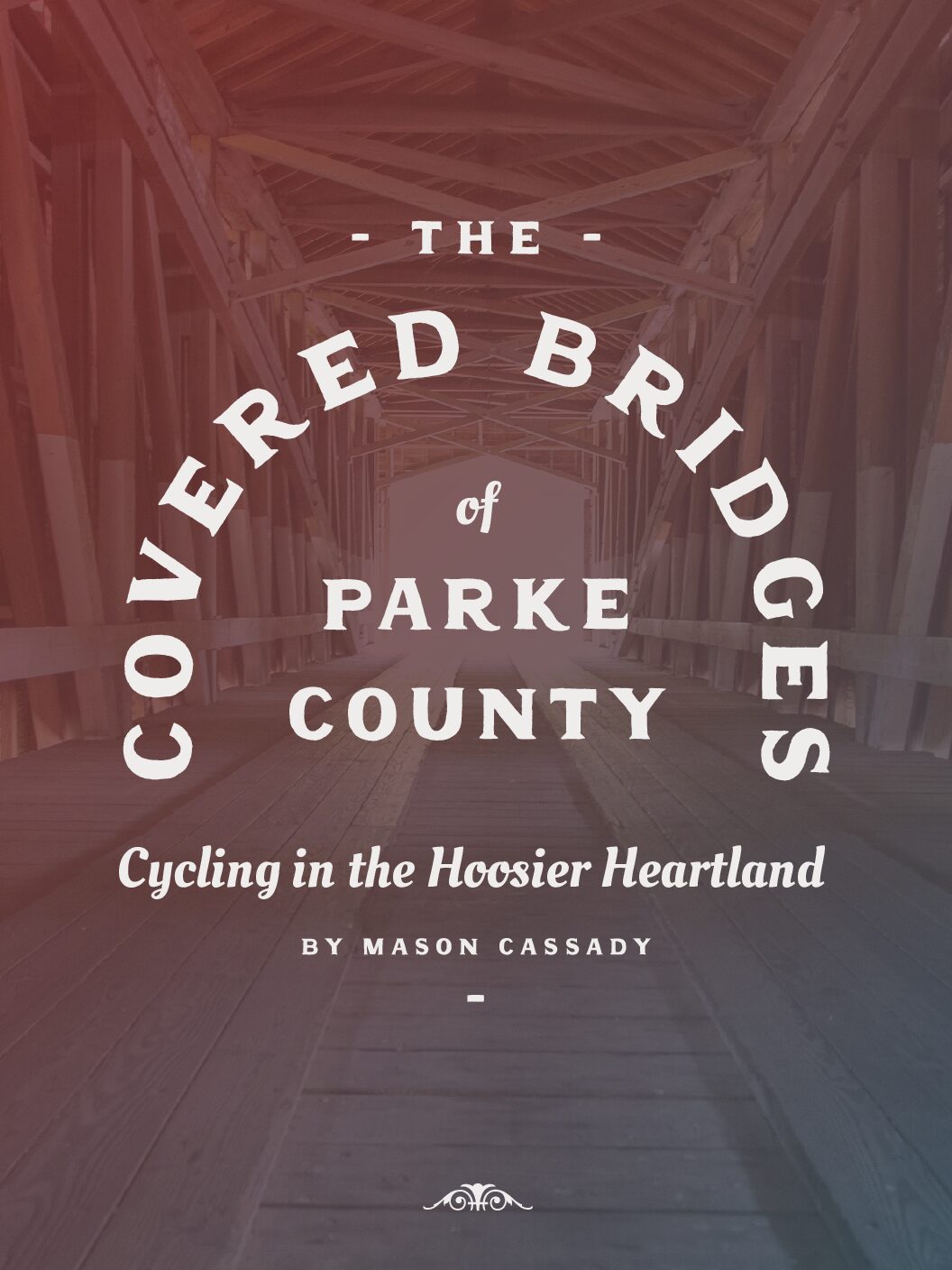
The Covered Bridges of Parke County
Cycling in the Hoosier Heartland
By Mason Cassady
Sometimes I wonder, what does it mean to be a Hoosier?
Perhaps a futile question to ask as there is certainly more than one answer. Hoosier-ness could be found in a variety of things: Teeth-deep in the flavors of sweet corn off the cob on a summer night. Skippin’ rocks with a pal at your favorite local swimmin’ hole. It could be experienced in the hot mess of the Indy 500, chock-full of Budweiser and fried food. Maybe it’s seen in red barns on a backroad in autumn. Or it could be found in a forest hike searching for morels or chanterelles. Maybe it exists in the fruit of pawpaw and persimmon trees.
One avenue down Hoosier lane is Parke County, Indiana, the uncontested Covered Bridge Capital of the World, where a whopping 31 covered bridges stand today (Putnam County with nine is the second highest in the state). With such a large number of historic bridges in Parke County, it only makes sense to hold a Covered Bridge Festival every year. As leaf-peeping season takes off in October, visitors from around the world flock to Parke County. To my surprise, organizers say that the festival attracts up to 2 million annual visitors. As with much else in the year of COVID-19, the festival (which would have been the 64th) has been cancelled. That said, the bridges are still open to those who would like to make their own trip.
In my quest to uncover more qualities, character, and sentiments of being a Hoosier, I drove northwest from Bloomington with my bicycle in tow to tour this little corner of Indiana. Along the way, I visited restaurants and bars, talked with locals, camped at parks and perused antique shops in hopes of finding more answers to a uniquely Indiana question: What in the heck does it mean to be a Hoosier?
Night 1: Route Planning in Rockville
I arrived at Rockville, the recommended starting point for visitors. The county seat, Rockville is smack-dab in the heart of Parke county. The population is roughly 3,000 people and the layout includes an attractive town square, a picture-worthy limestone courthouse, a handful of eateries, antique shops and the historic Ritz Theatre. Rockville is home to the Old Jail Inn, where guests can Spend The Night Behind Bars. Nine cells have been turned into guest rooms named after fabled criminals such as Jesse James. Below the cells is the Drunk Tank Winery, where guests can do as the title says in their pseudo night in jail.
First on my to-do list was to pick up a color-coded map at the Rockville Visitor Center. Some route planning for my bicycle bridge odyssey was in order, so I went to the Thirty-Six Saloon, a local biker bar for grub and while I looked at the map. I sat in the Hog Pitsection, an offshoot of the main restaurant. Nascar memorabilia, taxidermy and neon signs lined the walls. I asked the bartender what he likes, and he said “I’m all about that Biker-Babe burger, which is topped with brisket, pepper jack, fried onion straws, fried pickles, all smothered in BBQ sauce…” I replied, “you had me at Biker-Babe, I’ll take that and a Budweiser.” I was tempted to order an appetizer called Hog Turds but I don’t think I would have lived to tell this story. As I devoured the burger, the luscious lyrics of Cardi B in the song WAP poured out through the speakers while a boozed-up biker chick danced her boots off in the middle of the bar. I reveled in the moment as I thought to myself, if I could choose to be anywhere in the world right now, it is right here. As I finished my WAB (wet ass burger), I found home for the night at a campsite within the Rockville Lake Park, a 400-acre facility just a couple miles from the town square.
Day 1
My Routes: sections of Blue, Yellow and Brown
Distance Covered: 50 miles
Bridges Visited: Narrows, Cox Ford, Wilkins Mill, Jackson, West Union, Melcher (6)
Other Highlights: Turkey Run State Park, Sugar Creek, Turkey Run Gas & Grill, and Bar Cooler Pub & Grill
Soon after I woke up from camping, I needed fuel for the road ahead. Coffee and donuts were the first obvious choice so I ventured down to Wheelhouse Donuts right away. I follow a basic American donut shop principle: never order just one and so I went glaze, Maple Nut, and the Cereal Special (Vanilla cake donut, strawberry icing, fruity pebbles). One hot cup of creamy coffee to wash it down and I was off like Dorthy in the Wizard of Oz, singing and pedaling to discover the bridges of Parke County. Most visitors of the Covered Bridge Festival travel by car, some by motorcycle and few go by bicycle. I am one of those few.
My first day consisted of exploring bridges north of Rockville and so I cycled on the Blue Route on Marshall Road. As I biked along country roads, between fields of corn and soy, it gave an image of scenes from Bloomington’s cult classic film Breaking Away. As a cyclist in a car-centric country, I felt a bit like Dave Stohler, the main character who is obsessed with Italy and at odds with his traditional father. In this situation, I as the young bicycle rider and Parke County as the traditional, conservative, “my way or the highway” father figure. (Makes sense?)
Within an hour, I found myself at the first covered bridge on my route: Narrows Bridge. This bridge stands above Sugar Creek on the eastern edge of Turkey Run State Park. Built in 1882, it is considered by many the most scenic of them all. I walked about the bridge and peered out through windows with a nice view of sugar creek. Families in kayaks and canoes floated down the river one by one, giving me another activity found in the Hoosier way.
Westward ho, I biked alongside Turkey Run State Park on IN-47. This is a beautiful stretch of road where the initial signs of autumn ignited leaves on throughout forest foliage and gave way to yellows, oranges and reds. As if covered bridges weren’t enough to bring you to Parke County, the addition of fall colors at festival time round out the experience. Can I get an amen? Or, actually, I’ll just take a Pumpkin Spice Latte from my neighborhood Starbucks.
Not far away, I reached two more bridges, Cox Ford and Wilkins Mill. I gave a quick glance at the two bridges and creeks below. Interesting as they were, I gave more time for a favorite Hoosier pastime: searching for pawpaws. Colloquially known as the Indiana Banana, are unique in that they are the only member of their plant family growing outside of the tropics. Out of luck on the fruit hunt, I pedaled forth into a sunny Hoosier day.
As I approached the small town of Sylvania, I took a left to go south where the Yellow and Blue routes join. A couple miles down the road and I was at Jackson Bridge, the longest single span covered bridge in Indiana. This bridge is painted white while many bridges are painted red. If that doesn’t knock your socks off, I don’t know what will. From there, I continued cycling and found myself at the West Union bridge, which is the longest two span covered bridge in Parke County at 315 feet.
Around lunchtime, I neared the town of Montezuma which is named after the last Aztec emperor of Mexico. I was in need of food and drink so a quick look at the map, and I found a place called Bar Cooler Pub & Grill, just across the Wabash river in Vermillion County. As I swung the doors open, it was as if time reversed with my steps into the tavern. Four older men playing billiards looked at me with a “who’s this guy” facial expression as I found a seat at the end of the bar. Dark and reeking of tobacco smoke, the barkeep said, “Whatcha havin’?” I looked up and down the fridge and replied “Give me a Miller High Life.” I began to look the menu over while a middle-aged man seated next to me gave a rundown of the menu items. Head-to-toe in a Trump hat, camo shirt and jeans, the guy was very friendly which caused a slight short circuit in my brain due to the arrogant and gut-wrenching behavior of the guy on his hat.
Among catfish and other things, I chose a classic Hoosier sandwich: the pork tenderloin. And in typical Hoosier fashion, the pork was about as round as a volleyball with a bun the fraction of the size. As I inhaled the sandwich, the man and his friends told me about the Newport Hillclimb, another popular festival in the region. From my understanding, the event consists of classic cars racing up a hill. My bar mate bought me another Miller High Life, and I teetered back to my bicycle to ride 10-some miles back to Rockport.
Along the way, I came across Melcher bridge on Strawberry road with three other names: Klondyke, Marion and Leatherwood.
-

Belarus or Bust
One Hundred Forty-Three Down, Fifty to Go
By John Linnemeier
The world is a book and those who don’t travel read only one page.
–St. Augustine
A person’s lifespan is long. But it’s not endless. The earth is immense. But it’s not infinite. If you start early enough and make it your goal to see all 193 countries, it’s doable. At 75, I’m unlikely to make it, but there’s a small band of travelers who are attempting to see them all, and they’re a darned interesting bunch. All have incredible stories to tell, and all have been places you haven’t. You’re more likely to run into them in Djibouti or Somaliland than Paris or Mumbai.
Belarus is a tiny, off-the-beaten-track, landlocked country of 9.5 million, bordered by Latvia, Lithuania, Poland, Ukraine and Russia. It probably isn’t on most people’s bucket list, though perhaps it should be. I chose to visit, for three reasons:
- I’d never been there
(B) Demonstrations aimed at toppling Alexander Lukashenko, the man who’s been called Europe’s last dictator, were ongoing, so I might see a historical moment.
(C) Due to the pandemic, it was one of only 20 countries Americans could visit.
Researching a trip is just another aspect of travel that I’ve learned to savor. While attempting to better understand the country I was about to visit, I discovered a marvelous book, Voices from Chernobyl, by Belarus’s Nobel Laureate, Svetlana Alexievich. The twenty stories narrated in the survivors’ own words gave me valuable insights into Belarusians’ character and their willingness to sacrifice and accept hardship.
The Chernobyl nuclear reactor is located in Ukraine, but since Belarus is downwind, it received the brunt? of the deadly radioactive damage. Even today a third of the land in Belarus has high levels of radioactivity. There’s a joke here that after Chernobyl you can eat anything you want
,– but you have to bury your own shit in lead.I’d read that for $650 I could take a tour of the affected area, but weighing the pros and cons, I decided against it. Belarus is quite affordable, and there are far more pleasant ways to stretch a dollar in Minsk.
For under $100 I booked myself into the best hotel in the capital, a gorgeous ten story fin de siècle confection, that like most of Minsk was completely rebuilt after having been blown to smithereens during the ”Great Patriotic War.” After several long arduous flights –including an overnight stop in Istanbul in the world’s largest terminal– I arrived at the pocket-sized Minsk airport, where I was shocked to find virtually everyone… maskless! It may come as a shock to many people, but since Covid-19 began, Belarus has never shut down a single school or business, and no one has ever been required to wear a protective mask, though a few choose to.
Their Covid-19 deaths per million are roughly one seventh ours. Make of it what you will.
A gentleman in a Mercedes
,who spoke not a word of English,picked me up at the airport and drove me through fertile gently rolling farmland into the heart of the spotlessly clean capital city of Minsk. Every night the streets are washed down by large noisy trucks, and during the day uniformed babushkas bustle about in an attempt to sweep up non-existent trash.In Belarus it’s easy to break out of the tourist bubble since tourists hardly exist. For my first three days at the Europa Hotel I actually thought I was the only guest. That’s not to say that Belarus is cut off from the world. Many people speak English. You can watch CNN, RT, Nickelodeon or the BBC any time of the day or night, and internet speed is super-fast. There’s even a booming IT sector. The hugely successful massively multiplayer online game, “World of Tanks,” was created at a nearby technical park by a Belarusian company named Wargaming. All support for it is done locally. President Lukashenko once appeared to gloat when a multi-million-dollar hack was discovered to have originated in Belarus and he said, “Of course we abhor such activity, but one can’t help but be impressed that our people are capable of such things.”
I developed a real fondness for this miniscule country and its noble citizenry.
Belarusians know far more about us than we know about them. I could have watched demonstrators stream below my balcony while listening to Westerners comment on politicians and reporters ejected from the country and demonstrators arrested by the police… all from the comfort of my luxurious hotel room… I detected no censorship.
Curiosity about the demonstrations aimed at unseating Lukashenko hadn’t been the main reason I’d chosen to visit this small nation bereft of snowcapped mountains, ancient ruins, tropical reefs, or ferocious wild animals–the kinds of things that ordinarily draw visitors to a place–but since I was here, why not check it out?
Despite my deteriorating physical condition, I was looking for trouble
,and not having much luck finding it. For the first several days all seemed to be peaceful and quiet, though to compensate, the food was scrumptious and the women were smoking hot. What I hadn’t yet realized was that demonstrations in Belarus are a Sunday activity. Walking around town on a Saturday I thought I’d survey how many people were wearing masks. By my count out of 193, only 3 were wearing one, and that included a schoolyard full of kids.By Sunday morning, crowds were beginning to form, and I could hear supportive horns honking, so I decided to hit the streets. The concerned young woman at the desk advised me to stay clear of riot police, and I assured her I would. First though, I wanted to dive into a hearty Belarusian breakfast of eggs, cabbage, bacon and pickles, washed down with a strong cup of coffee, served up by a typically gorgeous young waitress.
Fortified, I was prepared to face the challenge of the new day.
The demonstrators were a joyful bunch. There was a sea of colorful red and white flags that have come to symbolize the rebellion, with several signs lauding a local grandmother who’d achieved celebrity through a picture of her tussling with several oversized riot police. A couple of people were dressed as dinosaurs, meant to mock the man many Belarussians see as a relic from another era.
From my limited point of view, he didn’t appear to be one of those dictators who requires all businesses to display his photo, nor are there statues of him on every corner, striking heroic poses. I’ve seen worse. Working in Iran during the reign of the Shah before the revolution, I observed what had seemed to be universal adoration turn to disgust and hatred for the same man when he looked like he was on the way out. It made me more cautious in judging how much weight to give to the support people claim to have for any strongman in a dictatorship. There’s a calculation that goes on in most people’s heads… you don’t want to be on the losing side.
As I walked along with the happy throng, I was approached several times and politely asked where I was from and what I was doing here. When I told
thempeople I was American, they were both amazed and delighted. They all thanked me profusely for taking an interest in their struggle. When I pressed them to explain their objectives I never heard anything other than a desire to be rid of an odious dictator. They never spoke of joining the EU or NATO, nor did I detect any pro or anti-Russian sentiment. Surprising to me, I didn’t see any support for Sviatlana Heorhiyeuna Tsikhanouskaya (maybe they couldn’t fit it all on a protest poster,) the runner up to Lukashenko in the most recent election. What I did hear over and over again was that they saw themselves as a unique people, with their own language, history (way too convoluted to explore here!), customs and heroes. They wanted to go their own way… independent and free from alliances with any particular camp and their over-arching agendas.I told them I agreed with them totally but feared that the great powers would attempt to co-opt their revolution.
As I marched along, I noticed something peculiar. Along the main drag was a small coffee shop with customers lined up out the door and around the block. Curious, I peeled off from the river of demonstrators and made inquiries with the apparently caffeine-starved line-standers (none of whom, incidentally, were observing social distancing). They informed me that the café doors had been smashed-in by the cops, and everyone wanted to make sure that the owner wouldn’t suffer any financial loss.
I was beginning to develop a real fondness for this miniscule country and its noble citizenry.
I witnessed one shocking event. As I was walking along with the ebullient but peaceful crowd, I heard a tremendous commotion and everyone began running away fearfully. In no more than fifteen seconds several heavy-duty trucks erected a substantial twenty-foot barrier that totally blocked off an intersection…an amazing display, and very intimidating. Safely back in my hotel room I turned on BBC to discover that a dozen demonstrators had been seized by police and some dissident had been detained at the Lithuanian border. It didn’t appear to me that Lukashenko was about to fall any time soon, though circumstances change and I could easily be wrong.
By Monday the city was calm again, so on my last full day, I visited the massive WW2 (referred to in Belarus, as in Russia, as the “Great Patriotic War”) Museum. It’s impossible to overemphasize the effect that great cataclysm had on this land and its people. They paid far more than their share of the butcher’s bill. During the Second World War the US suffered four hundred thousand casualties, while twenty-six million Soviets, who included Belarussians at the time, died during the same conflict. In other words, for every American causality, sixty-five Soviets died. Patriotism runs deep in this part of the world.
I noticed an imposing war monument in front of the museum where a press conference was being held. Some VIP was speaking to half a dozen TV cameras. Curious, I sidled up to the crowd and asked what was going on. An attractive middle-aged woman who spoke excellent English informed me that the VIP was the Russian ambassador to Belarus who was speaking on the anniversary of the lifting of the siege of Leningrad. I assume the underlying motivation for the speech was to emphasize the historic bond between these two countries that would be a shame to compromise regardless of whatever happened as a result of the current unrest.
I guess I looked like I might be a threat to the Russian Federation since two burly goons, obviously packing heat, peeled off from the ambassador’s entourage and began aggressively snapping away at me with their cameras. At my age I felt flattered to be deemed a threat to anything. And with that, my journey was complete: Not only had I finally found trouble, but I was the trouble. Nostrovia, goons!
[editor’s note: John Linnemeier’s book, How an Average Man Lived an Adventurous Life, is a must read for average people everywhere. Even for those of you who are slightly above average. In 2016, John ran for Mayor of Bloomington.]
